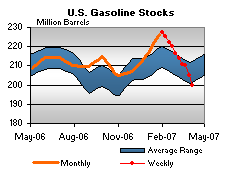The International Energy Agency warned Thursday that output by the Organization of Petroleum Exporting Countries had hit its lowest level in over two years on production outages and self-imposed cuts, a factor likely to drain global oil stocks in the coming months.
In its monthly oil market report, the agency, the energy security watchdog for the Organization for Economic Cooperation and Development, highlighted unexpected product-led reductions in world oil stocks and what it described as "astonishing" demand growth in China, where it was forced to revise up its growth expectations for this year.
Unexpected production outages in Nigeria and maintenance in Saudi Arabia contributed to OPEC's daily output in March falling to a little over 30 million barrels, the lowest since January, 2005.
This is a classic case of deliberately shrinking supply to drive prices up. And this tactic is working.
U.S. gasoline stockpiles fell 5.5 million barrels to 199.7 million barrels in the week to April 6, the biggest drop since Aug. 22, 2003, the U.S. Department of Energy reported yesterday. Supplies fell 12 percent the past nine weeks.
Here's a chart of US gas stockpiles.

Also note that demand is increasing:
Gasoline demand, which peaks between the Memorial Day holiday in late May and Labor Day in early September, was close to 9.5 million barrels in each of the Energy Department's past two reports, a level not usually seen until June.
Here's the result of all these events:
Gasoline prices were up again for the week of April 2, 2007, increasing 9.5 cents to 280.2 cents per gallon. This is the tenth consecutive week of increases; prices are now 11.9 cents per gallon higher than at this time last year. All regions reported higher prices. East Coast prices were up 8.4 cents to 275.5 cents per gallon. The Midwest had the largest regional increase, with prices rising 13.0 cents to 274.4 cents per gallon. Gulf Coast prices were up 11.0 cents to 267.5 cents per gallon, while Rocky Mountain prices increased 10.0 cents to 271.9 cents per gallon. West Coast prices were up 4.2 cents to 313.8 cents per gallon, with the average price for regular grade in California up 2.4 cents to 325.2 cents per gallon, 44.1 cents per gallon above last year's price.
Speaking of prices, here's a chart of oil.

The market dropped after the end of the Iran/Britain situation, but the market is still clearly in an uptrend. Considering the drop in US stockpiles, decreased oil output and increasing demand, we're in for some price pressures this summer.